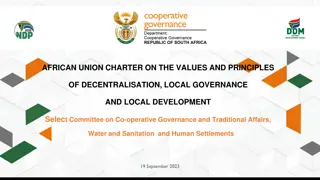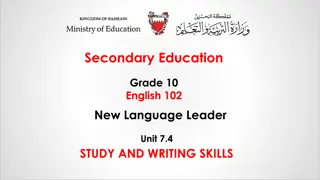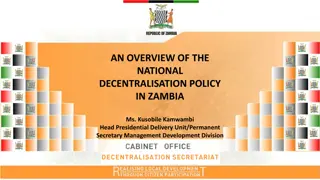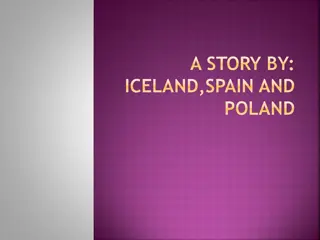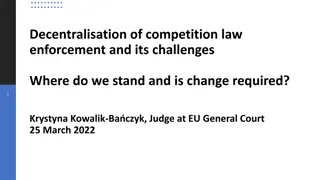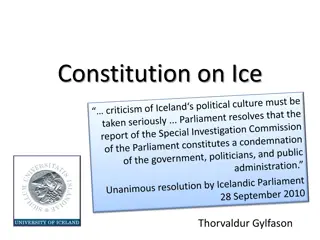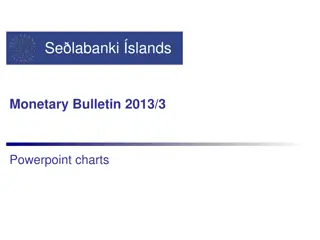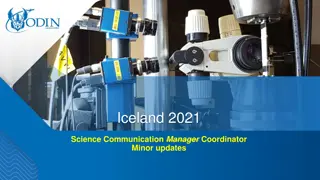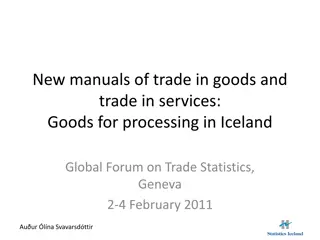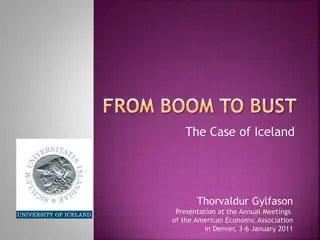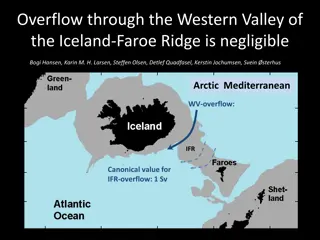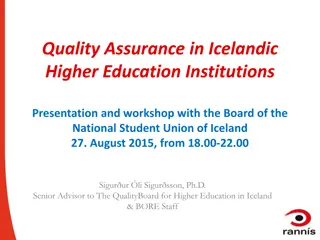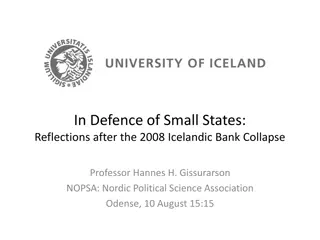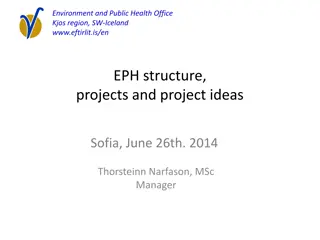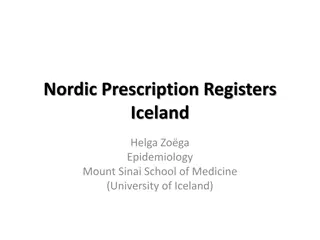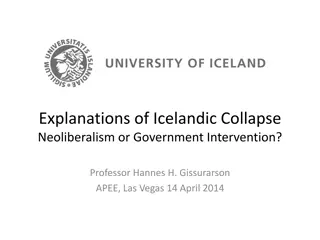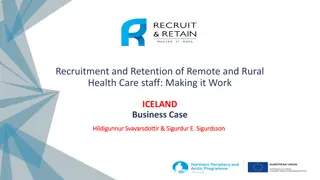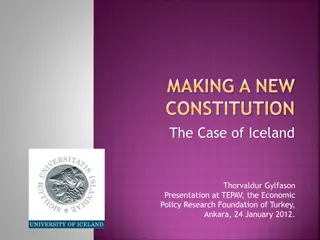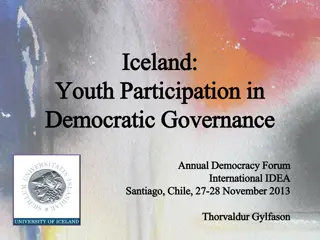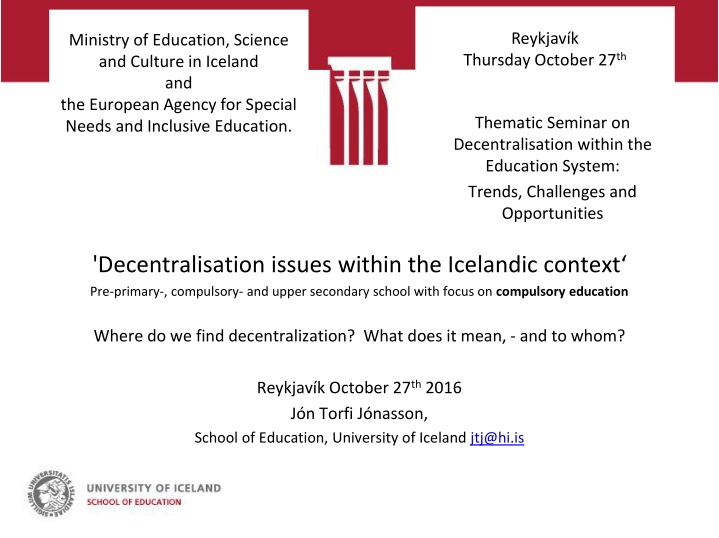
Decentralisation Issues in Icelandic Education System: Trends, Challenges, and Opportunities
Explore decentralisation issues within the Icelandic education system, focusing on pre-primary, compulsory, and upper secondary levels. Delve into the meaning of decentralisation, its implications, and key considerations for analysis. Uncover structural, pedagogical, and governance dimensions, questioning the system's centralized or decentralized nature.
Download Presentation

Please find below an Image/Link to download the presentation.
The content on the website is provided AS IS for your information and personal use only. It may not be sold, licensed, or shared on other websites without obtaining consent from the author. If you encounter any issues during the download, it is possible that the publisher has removed the file from their server.
You are allowed to download the files provided on this website for personal or commercial use, subject to the condition that they are used lawfully. All files are the property of their respective owners.
The content on the website is provided AS IS for your information and personal use only. It may not be sold, licensed, or shared on other websites without obtaining consent from the author.
E N D
Presentation Transcript
Reykjavk Ministry of Education, Science and Culture in Iceland and the European Agency for Special Needs and Inclusive Education. Thursday October 27th Thematic Seminar on Decentralisation within the Education System: Trends, Challenges and Opportunities 'Decentralisation issues within the Icelandic context Pre-primary-, compulsory- and upper secondary school with focus on compulsory education Where do we find decentralization? What does it mean, - and to whom? Reykjav k October 27th 2016 J n Torfi J nasson, School of Education, University of Iceland jtj@hi.is
How can we construct the analysis of the issue? Issues to consider concerning decentralization within education VII. Research projects VIII. Conceptual, structural and empirical issues revisited a) Structural heterogeneity, at all levels and along all dimensions b) Formal and imagined structures and influences, (explicit vs implicit) c) Competing structural dimensions d) Dilemmas: a) Top-down initiative, learning communities and teacher ownership of change b) Central aspiration and ambition, and formal responsibility, and the potential institutionalization of mistrust IX. Is the Icelandic system essentially centralized or decentralized? X. Where are we heading? I. A preamble: Which perspective is the most important one? Conceptual, structural and empirical issues Dimension 1 Management History of developments II. Governance, where and of what? III. Fiscal locus of control Dimension 2 Pedagogical support Dimension 3 Curriculum content, instruction, teaching material, national testing Dimension 4 School and teacher education and professional development II. III. I. IV. V. VI. J n Torfi J nasson and Gunnhildur skarsd ttir. (2016). Iceland: Educational structure and development. In T. Sprague (Ed.), Education in non-EU countries in Western and Southern Europe, pp. 11-36. Series: Education Around the World. London: Bloomsbury. ePub: 978-1-4725-9250-7 J n Torfi J nasson October 2016 2
A preamble: Which perspective or aspect, is the most important one? Talking about a system of education and how it is controlled* (e.g. centralized or decentralised), different actors focus on different dimensions or aspects of the system and thus take different perspectives and therefore come to different conclusions about the modus operandi. * Note, that I don t use the term administered It is also very important to distinguish between a formally correct (lean) description at one descriptive level and a more complicated (thick) description at another level which may convey a very different picture.# #The are systems which are being described as democratic, with elections, which most people know have preciously little to do with a democratic process. That is an extreme case of what I have in mind. J n Torfi J nasson October 2016 3
Conceptual, structural and empirical issues Structural heterogeneity, at all levels and along all dimensions Formal and imagined structures and influences, (explicit vs implicit) and Competing structural dimensions Levels and dimensions Very (or somewhat?) different for the three levels of education Depends on what decentralisation means and what criteria are use to judge it, e.g. Delegation Deconcentration Devolution Non-supportive devolution Supportive devolution Devolution with coordination - democratization Decoupling? A mixture, - both along different dimensions but also within the same dimension, because of the heterogeneity of municipalities! I suggest three+ principal dimensions Administrative and financial (related to management) Educational, pedagogic, psychological support and various expertise Curricular matters, involving curriculum guides, testing, external evaluation and potentially monitoring +Various actors active in the system All the terms for centralization are missing here J n Torfi J nasson October 2016 4
Dimension 1: Management J n Torfi J nasson October 2016 5
Some history of developments (primary compulsory) [The managerial - administrative and financial dimension] 1907-1974 Municipal control with considerable government input especially for the rural communities 1974-1995 Central control but with considerable sectoral strength, perhaps primarily in the various support services 1995- Reverting to the earlier system, but again with considerable central input In the following the historical developments of the substantive and technical aspects of decentralisation (and inclusion) - over the latter half of the 20th century and into the 21st , are discussed (in Icelandic) in the two volume history of Icelandic education 1880-2007: J n Torfi J nasson (2008). Grunnsk li ver ur til (6); Samr mdur framhaldssk li m tun (9); Fj ldi nemenda og fj rmagn (10); j nustustofnanir sk lanna (13); Innlend og al j leg vi mi (14); Sk li fyrir alla (15)? Chapters in Loftur Guttormsson (Ritstj.), Almenningsfr sla slandi 1880-2007. S ara bindi. Sk li fyrir alla. 1946-2007. Reykjav k: H sk la tg fan. See also other chapters in the volume. J n Torfi J nasson October 2016 6
Rangring ytra Sveitarf lagi Vogar Eyjafjar arsveit Stykkish lmur H na ing vestra Vesturbygg Bl ndu ssb r Bolungarv k Bl sk gabygg ingeyjarsveit Grundarfjar arb r Hrunamannahreppur Dalabygg Fl ahreppur Hvalfjar arsveit Sveitarf lagi Skagastr nd Vopnafjar arhreppur Dj pavogshreppur Langanesbygg H rg rsveit Sey isfj r ur Strandabygg M rdalshreppur Skei a- og Gn pverjahreppur Svalbar sstrandarhreppur H navatnshreppur Gr tubakkahreppur Gr msnes- og Grafningshreppur Reykh lahreppur Sk tusta ahreppur Skaft rhreppur T lknafjar arhreppur Akrahreppur sahreppur S av kurhreppur Kj sarhreppur Brei dalshreppur Skagabygg Eyja- og Miklaholtshreppur Svalbar shreppur Kaldrananeshreppur Borgarfjar arhreppur Helgafellssveit Skorradalshreppur rneshreppur Flj tsdalshreppur Tj rneshreppur 28 29 30 31 32 33 34 35 36 37 38 39 40 41 42 43 44 45 46 47 48 49 50 51 52 53 54 55 56 57 58 59 60 61 62 63 64 65 66 67 68 69 70 71 72 73 74 17,7 17,4 14,7 14,1 13,5 13,4 12,6 12,4 11,0 10,4 10,2 9,6 9,3 8,9 8,8 7,2 7,1 7,1 6,8 6,4 6,2 5,8 5,6 5,5 5,1 5,0 5,0 5,0 4,2 4,1 3,9 3,8 3,1 2,8 2,1 2,4 1,8 1,9 2,3 1,8 1,5 1,7 1,3 1,1 1,0 1,3 1,0 0,40 0,39 0,33 0,32 0,30 0,30 0,28 0,28 0,25 0,24 0,23 0,22 0,21 0,20 0,20 0,16 0,16 0,16 0,15 0,14 0,14 0,13 0,13 0,12 0,12 0,11 0,11 0,11 0,09 0,09 0,09 0,08 0,07 0,06 0,04 0,04 0,04 0,03 0,03 0,03 0,02 0,02 0,01 0,01 0,01 0,01 0,00 93,69 94,09 94,42 94,74 95,04 95,34 95,63 95,91 96,16 96,39 96,62 96,84 97,05 97,25 97,45 97,61 97,77 97,93 98,09 98,23 98,37 98,50 98,63 98,76 98,87 98,99 99,10 99,21 99,31 99,39 99,48 99,56 99,63 99,70 99,74 99,78 99,82 99,85 99,88 99,91 99,93 99,95 99,97 99,98 99,99 100,00 100,00 Relative size of municipality based on 0- 16 year olds Average in a cohort 1515,7 481,6 407,9 258,0 217,2 212,7 148,9 117,0 103,4 % of children Cumulative % 34,26 45,15 54,37 60,20 65,11 69,92 73,29 75,93 78,27 79,75 80,97 82,15 83,29 84,42 85,55 86,66 87,67 88,39 89,08 89,67 90,24 90,80 91,33 91,85 92,35 92,83 93,29 Municipalities with children (74) Reykjav k K pavogur Hafnarfj r ur Akureyri Reykjanesb r Gar ab r Mosfellsb r Sveitarf lagi rborg Akranes Fjar abygg Vestmannaeyjar Seltjarnarnes Sveitarf lagi Skagafj r ur Flj tsdalsh ra Grindav kurb r Borgarbygg safjar arb r Nor ur ing Hverager i Sveitarf lagi Hornafj r ur Dalv kurbygg Sveitarf lagi lfus Sn fellsb r Sandger i Rang r ing eystra Fjallabygg Sveitarf lagi Gar ur 1 2 3 4 5 6 7 8 9 34,26 10,89 9,22 5,83 4,91 4,81 3,37 2,64 2,34 1,48 1,22 1,18 1,14 1,13 1,12 1,11 1,01 0,72 0,69 0,59 0,57 0,56 0,53 0,52 0,50 10 11 12 13 14 15 16 17 18 19 20 21 22 23 24 25 26 27 65,6 53,9 52,1 50,6 49,9 49,7 49,3 44,7 31,6 30,5 26,3 25,1 24,9 23,4 22,8 22,2 J n Torfi J nasson October 2016 21,3 0,48 20,5 0,46 7
There are 74 municipalities (where there are some children) In one municipality there is a third of the school aged children The three biggest municipalities include 55% of the children Over 80% of the children are in the 10 biggest municipalities. Perhaps it would make sense to set our focus on these, but of course not neglect the children in the other 64 municipalities. So when we talk about Icelandic compulsory education and its operational setting, should we always talk about the situation in all 74 municipalities or perhaps focus on one, three, 10 or twelve or perhaps all 74? The last option is formally most correct, but is rarely relevant. I suggest that we make an important distinction between formalist and essentialist descriptions. And that we often lean towards the former when it would make more sense to lean towards the latter. J n Torfi J nasson October 2016 8
Dimension 1: The managerial dimension? Governance where and of what? Demography Locus of control outside government Municipalities local authorities in charge (play- and compulsory) Infrastructures Icelandic Association of Local Authorities - Samband slenskra sveitarf laga (The developments of its operation with respect to education) Electoral units, sectoral units Landsfj r ungar, kj rd mi, landshlutar, sv i Structural heterogeneity and connection across fields (Welfare units instead of school support units in some cases Rv k special case?; Fj lskylduskrifstofur etc. sta sk laskrifstofa) Lateral multidisciplinary vs horizontal mono disciplinary (educational) connections Governance of what? Dimensions of governance: administrative, fiscal, curriculum, outcome and quality, J n Torfi J nasson October 2016 9
The fiscal dimension depends on the level of education The fiscal responsibilities of municipalities The fiscal responsibilities of government Running and construction cost Depends on the level of education, but now all is carried by the municipalities for pre-primary- and compulsory schools and nationally for upper secondary education *Pay structures and agreements By consensus the pay agreements are done centrally The Local Authorities' Equalization Fund - J fnunarsj ur sveitarf laga It has a crucial role in equalizing operating costs, supporting special education, support of immigrants, + especially supporting the smaller communities J n Torfi J nasson October 2016 10
Dimension 2: Pedagogical support J n Torfi J nasson October 2016 11
Dimension 2: The substantive support system A somewhat missing link in my discussion but a very important dimension, perhaps the second most important one The educational, pedagogical, psychological, curricular support J n Torfi J nasson October 2016 12
Ministry control and initiation of centrally based development programs *Ministry of education and culture and the *Directorate of education (from Oct 2015) The Directorate was established, partly as a merger of two central bodies, N msmatsstofnun and N msgagnastofnun *Educational resource centre for the blind and deaf Special projects and activities *White paper: National literacy efforts *Mobbing project centrally run at one point? J n Torfi J nasson October 2016 13
Dimension 3: Curricular matters J n Torfi J nasson October 2016 14
Dimension 3: The curricular dimension Content, instruction, teaching material, national testing Curriculum Stipulated by law (in particular article 24) National curriculum guides for the three school levels Municipal guides often written for play- and compulsory school School guides *National centre for teaching materials (DoE) *National marking system (DoE) *National tests in grades 4, 7 and 10 (DoE) Induction of the curriculum (local?) J n Torfi J nasson October 2016 15
Ministry control and initiation of centrally based development programs Evaluation basically a central exercise Internal and external evaluations for formative feedback, as a part of the governments responsibility for quality education *System evaluations (OECD) *Evaluation of inclusive education *PISA and similar tests J n Torfi J nasson October 2016 16
Dimension 4?: Miscellaneous actors J n Torfi J nasson October 2016 17
Dimension 4?: Teacher education and CPD Teacher unions Essentially in one union, the Icelandic Teachers' Union, except music and upper secondary Principal Initial teacher education, Class teachers by two universities, art teachers by three Municipal or school based CPD no central control For no level in the system is there any notable central control of CPD *National Advisory Board for CPD A recently established advisory board meant to inspire development, dialogue and cooperation in the area The board is appointed by the minister of education, and represented by the ministry (also in the chair), by the teacher unions, by the municipalities and the universities Initially spurred on by the Icelandic Teachers' Union J n Torfi J nasson October 2016 18
Research part of dimension 4 Research projects Done both on a national and a municipal and school basis J n Torfi J nasson October 2016 19
Discussion Conceptual, structural and empirical issues revisited a) Structural heterogeneity, at all levels and along all dimensions The impossibility of painting a clear and simple picture of the system. Review the levels and the actors and dimensions involved and the heterogeneity in each case. Examples reviewed. Discuss. b) Formal and imagined structures and influences, (explicit vs implicit) The imagined control or freedom may be illusory or misconstrued and in fact be much more influential than the formal structures. These views may be very heterogeneous within groups, but even more so between groups. The recourse to formal documents will be of no avail. Explain and discuss. c) Competing structural dimensions The clearest or simplest dimensions described (and those most often mentioned) may be the least important ones and vice versa. Different dimensions may operate in opposite directions, but have very different relative weights, and those that are meant to be most important may turn out to be less important than others. Thus a system that seems central at first sight may indeed by decentral but also the opposite. Explain and discuss. d) Dilemmas related to the central-decentral issue: a) Government responsibilities, top-down initiatives, learning communities and teacher ownership of change or real partnership therein b) Central aspiration and ambition, and formal responsibility, and the potential institutionalization of mistrust. J n Torfi J nasson October 2016 20
Discussion Is the Icelandic system essentially centralized or decentralized? Very brief, and reverting to the previous discussion and then answer the question. Dimension 1 Management: Dimension 2 Support: Dimension 3 Curriculum: Devolution, but (e.g. Reykjav k) Devolution without much support Essentially centralised Dimension 4 Other actors: Centralised, but J n Torfi J nasson October 2016 21
Discussion Where are we heading? Research on these issues. More on where have we been. a) The changes towards decentralisation Administrative, fiscal, curricular, evaluative, pedagogic consultative, factors b) The changes involving centralisation Curricular, testing (national and international), school materials, c) What are the important changes to make? Discuss J n Torfi J nasson October 2016 22
Research on issues related to the form of control orsteinn S berg (2009). Flutningur grunnsk lans til sveitarf laganna, fj rhagsleg-, fagleg- og stj rnunarleg hrif Krist n Hreinsd ttir (2013). ar brenna allir m nir eldar. Um hrif sveitastj rna grunnsk lann. Hildur sp Gylfad ttir (2012). ekkingarmi lun hj stj rns slu slenskra sveitarf laga. skoranir og vinningur B rkur Hansen, lafur H. J hannsson og Steinunn Helga L rusd ttir. (2010). Faglegt sj lfst i grunsk la vi horf sk lastj ra. Uppeldi og menntun, 19(1-2), 51-70. B rkur Hansen og lafur H. J hannsson. (2010). Allt llu. Hlutverk fr slustj ra 1975-1996. Reykjav k: H sk la tg fan. Amal a Bj rnsd ttir, B rkur Hansen and lafur Helgi J hannsson. (2008). The influence of teachers in the operation of basic schools in Iceland. Scandinavian Journal of Educational Research, 52(5), 513 526. B rkur Hansen and lafur H. J hannsson. (2008). Issues arising from the decentralization of basic schools in Iceland. P. Hansson og K. Malmberg (ritstj rar) Education with a moral purpose. Educational leadership, management and governance for a sustainable future (bls. 44-51). Uppsala Universitet. Gu mundur . smundsson, B rkur Hansen, lafur H. J hannsson. (2008). Stj rnskipulag grunnsk la, hugmyndir sk lanefnda um v ld s n og hrif. Netla Veft marit um uppeldi og menntun. Grein birt 1. des. (13 bls.). B rkur Hansen, lafur H. J hannsson, Steinunn Helga L rusd ttir. (2008). Breytingar hlutverki sk lastj ra grunnsk lum kr fur, m tsagnir og togstreita. Uppeldi og menntun, 17(2), 87-104. Amal a Bj rnsd ttir, B rkur Hansen, lafur H. J hannsson. (2006). M tun sk lastarfs Hver er hlutur kennara? T marit um menntaranns knir (2006), 3. F lag um menntaranns knir (bls. 12-26). B rkur Hansen, lafur H. J hannsson, Steinunn Helga L rusd ttir (2004) Yfirf rsla grunnsk lans til sveitarf laga valddreifing e a mi st ring? Birt Netlu n vember 2004. B rkur Hansen. (2004). Heimastj rnun. hersla stefnum rkun um grunnsk la. Birt Netlu ma 2004 J n Torfi J nasson October 2016 23
Thank you J n Torfi J nasson October 2016 24

